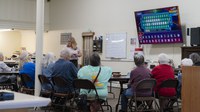NDSU Extension’s Aging in Community project expands to southern North Dakota counties
(Click an image below to view a high-resolution image that can be downloaded)
Aging in Community (AIC), the North Dakota State University Extension program focused on enhancing the lives of older adults, is beginning a new chapter of its initiative.
Phase II began on July 1 and involves expanding AIC from two pilot programs in Lisbon and western Morton County to 10 additional counties.
The AIC project is a model of community support designed to prevent or delay the relocation of older adults from their rural town. Program staff, along with the help of volunteers, support the older adults by providing transportation, food and nutrition classes, fall prevention education, technology assistance and more.
The program began in 2021, supported in part by a four-year grant from Margaret A. Cargill Philanthropies, and has since received another grant from Margaret A. Cargill Philanthropies to continue the work.
The AIC service area has expanded to the following counties: Slope, Hettinger, Grant, Bowman and Adams counties in the southwest, and Emmons, Logan, LaMoure, McIntosh and Dickey counties in the southeast.
Jane Strommen, director of the AIC program, says this expansion will help provide more services to address the most pressing needs of these rural counties that fit within the aging-in-place framework.
“We’re not a home health agency,” says Strommen, “but we can help people with their finances, social connections, transportation, housing, and health and wellness.”
With a larger service area comes more responsibilities. The program may delegate duties on a part-time position or contractual service basis.
“For a while, I’ve been asked about expanding from all over the state,” says Strommen. “Scaling up to reach as many people as possible takes strategic planning.”
Program leaders aim to engage with community members, NDSU Extension county staff and local leaders to provide resources to older people in small communities.
To kick off Phase II, area coordinators will connect with stakeholders in the expansion counties about the greatest needs of older adults wishing to stay in their communities. NDSU Extension’s leadership and civic engagement agents will help guide the needs assessment.
One of the focuses of this phase is to learn how this program provides value by delaying or preventing expenditures such as Medicaid.
Kyla Sanders, area program coordinator since fall 2021, says this expansion is a great asset for her service area in southwest North Dakota, where there are fewer than six people per square mile. She was previously the coordinator for western Morton County before her service area grew.
“Our rural North Dakota landscape isn’t getting any younger,” says Sanders. “It’s great to be able to reach more folks, because the need is there.”
Sanders says one thing she has learned, and will focus on more in this role, is the difficulty of navigating Medicare.
“There is food insecurity, housing issues – there are so many needs that are not being met,” says Sanders.
She is proud of her work bridging access to heating and housing assistance, and sees progress in the establishment of a new food pantry.
Katie Wentz, area program coordinator since early 2022, says AIC provides support for older adults not just to stay in their communities, but to live comfortably and thrive.
“It’s exciting to think about all the people we’re able to reach now, given the impact we’ve made in Lisbon,” says Wentz about expanding her service area to five counties.
The team has been assembling a toolkit for replicating this work. The collection will include position descriptions and processes for streamlining similar community projects.
Even though some of these procedures can be transferred to other parts of the state, Strommen says the next steps are to continue spending time in these towns, promoting the program and gathering key information about the communities’ unique situations.
Sanders notes that two towns she has served, Hebron and Glen Ullin, are about 15 miles apart, but they both have distinct needs.
“There’s no cookie-cutter way to do this,” says Strommen. “We will take the time to do this the right way.”
Wentz suggests that one way to get involved in this work is to become an AIC ambassador.
“Volunteers play a huge part in our program’s success,” says Wentz, citing her area’s volunteer transportation program as an example of support that couldn’t be possible without the generosity of others.
“If you are a person who would like to help older adults connect with local resources, programs and support, we would love to have you as a volunteer,” adds Sanders.
For more information about AIC, visit ndsu.ag/ndsuAIC.
NDSU Agriculture Communication – Oct. 31, 2025
Source: Jane Strommen, 701-231-5948, jane.strommen@ndsu.edu
Source: Kyla Sanders, 701-348-9907, kyla.sanders@ndsu.edu
Source: Katie Wentz, 701-683-8346, katie.wentz@ndsu.edu
Editor: Dominic Erickson, 701-231-5546, dominic.erickson@ndsu.edu



